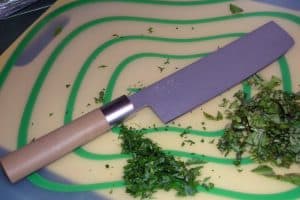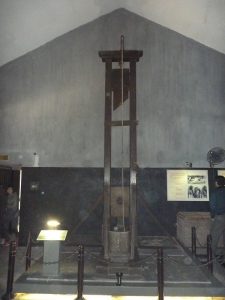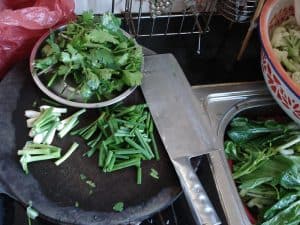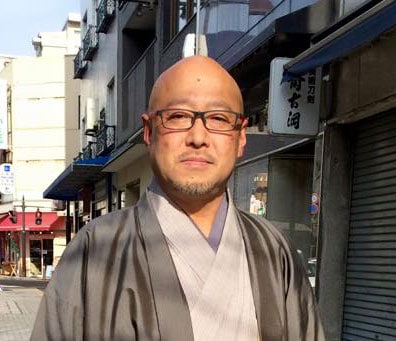TLDR; The short answer to the question “Should I buy a nakiri knife?” is YES if you cut a lot of vegetables in your daily routine.
If you are eyeing a nakiri knife and still confused about whether it’s the right option for you or not, this guide is for you.
If you’re lost in the wasteland of the plethora of Japanese similar knives. I’ll also illustrate the difference here.
N.B. If you decided to buy a nakiri knife, check our choices.
Do you need a nakiri knife?
The short answer is yes and no. Choosing a nakiri knife or not depends mainly on your needs, daily routine, and your skills.
Here are my 2 cents.
You need to buy a nakiri knife if you’re:
- A vegan, a cross-fitter, or with chewing problems who smokes veggies.
A mound of kale? Cabbage? Spinach? This thing will drop through leafy vegetables like nothing. It’s the dopest dope you’ll ever smoke.
- A home cook or a foodie who loves Japanese and Chinese food.
Need to cook a stir-fry meal for a family dinner? Prepping veggies for Sushi? Choy Sum? Or even prepare a salad for snacks? This knife will fit the bill.
- A beginner chef with low hand coordination.
The absence of a pointed tip in this “domestic blade” makes it safer and easier to control. - A knife-obsessed or a culinary student who wants to test-drive the profile.
Cap yourself on a small budget. Play with the profile. Use the whole thin blade barely touching your board. Exercise push-cutting. Make sure your first nakiri knife is easy to resell in case you don’t like it. - A pro cook for professional settings.
Whether you’re a line cook or a prep cook who deals with tons of vegetables daily, this thing is a top performer. It will shave a lot of the time used in raw veggies prep on the line. - A collector
Make sure to pick up this exquisite blade. It’s a great addition to your line-up.
You don’t need to buy one if you’re:
- A chef who needs an all-purpose knife.
If you’re on a budget and need ONE knife to handle all your kitchen work, this one is not for you. I recommend buying a gyuto in this situation. - If you do a lot of tip work.
Brunoiseing shallots or garlic, opening packages, and scoring can be a little bit difficult with a blunted tip. In this case, you need a knife to complement your nakiri. Or opt for a bunka if you need a flat edge with a pointed tip.
N.B. The sharpened heel of the nakiri can replace the tip, yet it needs some practice. - A rock chopper
IMHO, push cutting is easier to learn than rock chopping. But if you’re not planning to change your style, this won’t be the smartest choice.
What is a nakiri knife?

A nakiri Knife, also misspelled as nikiri, is a Japanese-style knife used for chopping, mincing, and dicing vegetables. You can use the nakiri knife for preparing ingredients for a veggie stir fry recipe. Or for chopping 10 onions for a french soup. Or even for doing sweet potato hash and coleslaw.
In An Edge in the Kitchen Book, Chad Ward writes that nakiri translates to “knife for cutting edible leaves.” So, they are designed mainly for shaving vegetables. The knife excels at chopping (push cutting) more than slicing.
Don’t worry, we will explain the nakiri knives technique later.
If you’re not familiar with Japanese kitchen knives, the nakiri vegetable knife will attract your attention with its interesting shape. It looks like a guillotine. The nakiri bocho has a boxy square blade with a flat profile, a blunted tip, a thinner spine, and a lightweight.

Types
There’s plenty of classification to the kitchen knives that you should be aware of.
Mass Produced Knives
Mass-made knives do have their advantages in terms of build quality consistency, ease of maintenance (stainless steel), and availability. As you can find them with the same quality at Amazon, William Sonoma, Sur La Table, etc.
On the other hand, they tend to be a little bit overpriced for what they offer.
Shuns, Myabis and Globals are good presentations of this type.
Hand-Hammered
Those are knives that are made with an artisan blacksmith. There’s a history behind every blacksmith or every knife. These blades are way cheaper as the makers have fewer marketing expenses.
In contrast, the quality may differ from one knife to another.
Custom nakiri
This is the wild-west of the kitchen knives. You must be an expert to make the right choice here. You can find them on Etsy, Facebook groups, and Instagram.
As a knife nerd, I love hand-hammered ones. Yet, there’s nothing wrong with the factory knives.
Again, it is a purely personal preference. So, opt for the one you like.
You can find these types in the Chefknivestogo store in the US and Knifewear in Canada.
Another classification here is:
Traditional vs western-style Nakiris
Typically, a traditional nakiri knife comes with a flat profile, half-tang, D-shaped wood handle, and small belly. Tojiro ITK and Moritaka are good examples.
Western-style nakiris tend to have a more prominent belly, triple-riveted western handle, and full tang. Wusthof is the example here.
Western knives are more versatile as they allow you to utilize rock chopping motion. But this comes as a trade-off for the performance of other techniques.
Choose whatever you want here. I recommend choosing western or hybrid types (Shun, Kai, and Mac) for beginners. Why? Because they’re mostly easier to maintain and will give you more mileage.
What are the advantages of Nakiri knives?
Here’s what is great about the nakiri bōchō.
- Razor-thin, even slices: The flat profile and the thinness will allow for you to have great uniform slices. No more unmatched cuts. You can now use tomatoes, lemon, and orange slices as a garnish with no problem.
- Clean Cuts: The flat profile allows for full contact between the flat blade and the cutting board. You will get full threads when mincing herbs like parsley. Every string will be separated without sticking to each other.
- Effortless cutting: You don’t need to apply extra pressure during cutting dense root vegetables. There’s no place here for pulling. Just push.
- Brilliant blade length: The genius about the nakiri is that it has a medium-sized blade. It’s not very long nor too short. That makes all your cutting power concentrated in 5-7 inches. The whole blade also comes across and down the vegetables producing more contact. That explains why these kitchen knives perform well. Also it makes slicing long vegetables extremely simple.
- Safety: Thanks to the lack of a pointed tip, it’s much safer to use the nakiri especially if you have low hand coordination.
- Beginners-friendly: Choosing your technique and style is purely a personal preference issue. Yet, the push and the up and down techniques are IMO easier to learn compared to the rock chopping motion.
- Time-Saver: This benefit is more noticeable in the professional environment. For example, a line cook in a saute station spends 50 hours weekly prepping tons of vegetables. The wonderful nakiri would save him a lot of time.
- Perfect for delicate vegetables: A nakiri Japanese knife with its thin, flat profile will cut vegetables without mangling or squishing. You can notice that while cutting basil. The basil will stay green without bruising or oxidization.
- Suitable for left-handed people: Nakiri bocho is a double-beveled knife (double-edged). So unlike, other Japanese knives, both righties and lefties can use it.
- Wide blade: That will ensure you have ample knuckle room to keep them away from hitting the cutting board. It also will allow you to scoop ingredients from the board to the pan.
How to use a nakiri knife?
There’s a BIG difference between the slice cut and the chop one. A nakiri is a chopper rather than a slicer.
Here’s how you can hold and use it.
- Hold the knife by its handle. Put your thumb and pointer finger around the spine while your other fingers clutching the handle. That’s what we call “ a pinch grip”. This will give you more security and control.
- Use your other hand as a guide for your cutting. Put your fingertips under your knuckles including your thumb. This is known as “ a claw grip”. This will protect you from cutting your finger off. Place this claw on the top of food during chopping.
- You now have 2 options. You can strike the knife up and down (up and down motion). Or move the nakiri blade forward across the food parallel to the board ( push-cutting motion).
If you’re still unable to pull the trigger and confused about the difference between nakiri and other Japanese knives, let me explain.
Nakiri Vs Usuba
Here’s my detailed guide about “nakiri vs usuba“, check it if you’re interested.
I’ll borrow Chad Ward’s words stating the difference between both types in his book.
” The word “usuba” is used for the single-beveled restaurant-style version of this knife. An usuba generally has a higher level of fit and finish and greater heft. It has a thick spine just like the single-bevel yanagiba and deba. The single-bevel usuba is generally for professional restaurant use while the thinner double-beveled nakiri is found in the home.”
Bottom line
You can use both types for cutting veggies, But, nakiri is a Japanese knife that has a ryoba ( double-bevel). Yet, usuba has a kataba (single bevel). Nakiri is lighter, wider, and thinner. The usuba knife is more intended for professional use. You would need more skill to use it.
Usuba is more specialized for extremely thin slices and small intricate work like performing Katsura-muki cuts.
N.b. Many knife makers use the two terms, “nakiri” and “usuba”, interchangeably in their product’s names.
Santoku Vs Nakiri
Check my detailed guide about “nakiri vs santoku“, check it if you’re interested.
A santoku knife might evolve from Japanese vegetable cleavers. The word “Santoku” means “three virtues”. That means it can cut vegetables, fish, and meat. So, it is a general-purpose kitchen knife and more versatile than a nakiri.
The Santoku blade shape is also different from nakiri. It’s more compact with a sheepsfoot curved blade to a 60° angle and a flat edge. This flat edge makes it capable of producing full cuts like nakiri.
Usually, I use a nakiri for prep work when I’m julienning peppers or onions and leave my santoku knife for cutting already-cooked meat and other pantry tasks.
Nakiri vs Gyuto
That’s a hard one. Well, I love my gyutos. They are my go-to knives for tackling plenty of knife work. I recommend them when you don’t have the welfare of buying 2 or 3 knives.
Yet I believe that you need to use specialized knives like a nakiri beside all-purpose knives if you’re serious about Japanese cuisine. To complement the nakiri, you might need to pick up a gyuto or a paring knife as well as a deba knife..
Although a gyuto knife is a better multitasker than a santoku knife, the nakiri is way more efficient at cutting vegetables and easier to control. If you’re a prep cook with high work capacity, that’s a day and night difference.
Nakiri vs Chef knife

It all comes down here to your style and your preference. Are you a rock-chopper or a push-cutter?
The western chef’s knife is another example of an all-around blade that lends itself towards western-type cooking. Unlike the Japanese vegetable knife with squared-off tips, it has a big belly. So, you can use your nakiri for push-cutting technique while utilizing the chef’s knife for rock-cutting motion.
Nakiri Vs Chinese cleaver (CCK)

Nakiri is a small cleaver. Yet, it’s narrower, lighter, more precise, and has less mileage compared to CCKs. That said, Chinese vegetable cleavers are capable of chopping vegetables, slicing meat, and crushing nuts and garlic. They perform better with hard vegetables like squash.
Yet, they’re kind of an overkill for small veggies as they tend to cause tearing rather than chopping in many cases.
FAQ
Can you use a nakiri knife to cut meat?
Nope, you shouldn’t use the Nakiri’s blade for cutting meat or hard foods. Nakiri’s edge can get dinged up with such tough uses. A nakiri knife is used for chopping vegetables into fine cuts. You can use it for preparing recipes like coleslaw or for cutting up veggies for salads and soups.
Bottom Line
Whether you’re a noob chef or you’re the next Rob Feenie, a nakiri knife will add great value to your kitchen. The only condition here is that it fits your style and needs.
Go grab this bad boy and let all the veggies tremble at your might:).

My name is Kenzo Kishita. I’m a retired cook and a knife nerd. Now I’m a full-time home cook and a passionate blogger. Here in the blog, I share with you my love for knives and cooking.
